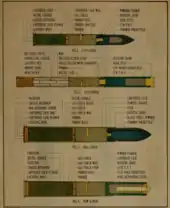Davis gun
The Davis gun was the first true recoilless gun developed and taken into service. It was developed by Commander Cleland Davis[1] of the US Navy, in 1910, just prior to World War I.
| Davis Gun | |
|---|---|
 Davis gun mounted on Curtiss F5L anti-submarine seaplane | |
| Type | Recoilless cannon |
| Place of origin | United States |
| Service history | |
| Used by | Royal Naval Air Service |
| Wars | World War One |
| Production history | |
| Designer | Cleland Davis |
| Designed | 1912-1914 |
Description

Davis' design connected two guns back to back, with the backwards-facing gun loaded with lead balls and grease of the same weight as the shell in the other gun, acting as a counter. His idea was used experimentally by the British and Americans as an anti-Zeppelin and anti-submarine weapon[3] mounted on the British Handley Page O/100 bomber and the American Curtiss HS-2L and H-16 (flying boats)[1] respectively. The direct development of the gun ended with World War I, but the firing principle has been copied by later designs.
Statistics
The gun was made in three sizes of 1.57 inch (3.9878 cm), 2.45 inch (6.223 cm), and 3 inch (7.62 cm), firing 2 pounds (0.91 kg), 6 pounds (2.7 kg) and 12 pounds (5.4 kg) shells respectively.[1] The 3 inch (7.62 cm) carried a pressure 15 tons per square inch when fired. Usually a Lewis machine gun was mounted on top of the Davis gun's barrel which was then used for sighting and as an auxiliary and anti-aircraft weapon.
Surviving examples
There are examples still at the Naval Aviation Museum at Pensacola, Florida, the Imperial War Museum in London.,[1] and the Kentucky Historical Society in Frankfort, Kentucky.
External links
References
- "Post The Davis recoilless gun". www.theaerodrome.com. Retrieved 19 November 2012.
- United States. Navy Dept. Bureau of Ordnance (1923). Ammunition : instructions for the naval service, 1923. Washington, D.C.: Government Printing Office. p. 162.
- "DAVIS AMMUNITION". www.big-ordnance.com. Retrieved 19 November 2012.